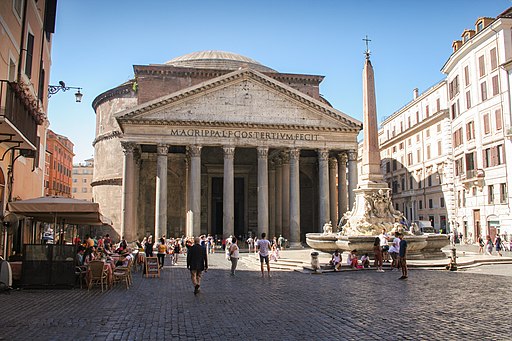
“Interior of the Pantheon, Rome” by Giovanni Paolo Panini depicts the interior of the famous and best-preserved of all Ancient Roman buildings, the Pantheon.
The Pantheon has been a prominent tourist attraction in Rome for hundreds of years. Built by Hadrian in 113–125 AD, this grand domed temple has survived structurally intact because it was consecration as a Christian church, “St. Mary and the Martyrs”, in 609 AD.
Panini populated the scene with foreign visitors. He featured a diverse mix of Romans and visitors from all parts of society. They congregate in the Pantheon to pray and to admire the fantastic architecture.
Panini exaggerated the perspective to provide a broader view of the interior than is possible from any single vantage point. The viewpoint is deep within the building, facing the entrance.
The portals open to the colossal columns of the porch. The painting shows a glimpse of the obelisk in the piazza before the church.
Through the central opening, called the Oculus, to the sky in the center of the dome, Panini revealed the bright blue sky flecked with clouds. Panini became famous in documenting with specific skill and vibrancy the monuments and views of Rome.
Pantheon, Rome
The Pantheon (“temple of all the gods”) is an ancient Roman temple, now a church, in Rome. It was built on the site of an earlier temple, and it was completed by the emperor Hadrian and dedicated about 126 AD.
Hadrian chose not to inscribe the new temple but rather to retain the inscription of the older temple, which had burned down.
The building is cylindrical with a portico of large granite Corinthian columns under a pediment. A rectangular vestibule links the porch to the rotunda, which is under a coffered concrete dome, with a central opening (oculus) to the sky.
Almost two thousand years after it was built, the Pantheon’s dome is still the world’s largest unreinforced concrete dome. The height to the oculus and the diameter of the interior circle are the same, 43 meters (142 ft).
The Pantheon is one of the best-preserved of all Ancient Roman buildings because it has been in continuous use throughout its history.
Following the fall of the Roman Empire, and since the 7th century, the Pantheon has been in use as a church informally known as “Santa Maria Rotonda.” The square in front of the Pantheon is called Piazza della Rotonda.
The Pantheon’s large circular domed cella, with a conventional temple portico front, was unique in Roman architecture.
Nevertheless, it became a standard example when classical styles were revived and have been copied many times by later architects. The form of the Pantheon can be seen in many buildings built in the 19th and 20th centuries.
It is especially prevalent in government and public buildings, city halls, universities, and libraries, echo its portico-and-dome structure.

External view of the front of the Pantheon, Rome
Giovanni Paolo Panini
Giovanni Paolo Panini, or Pannini (1691 – 1765), was a painter and architect who worked in Rome and is primarily known of his vedutisti (“view painters”).
Among his most famous works is his view of the interior of the Pantheon, and his vedute—paintings of picture galleries containing views of Rome. Most of his works, especially those of ruins, have a fanciful and unreal embellishment characteristic of imagined architectural themes.
Panini’s style influenced other vedutisti, such as Antonio Joli, Canaletto, and Bernardo Bellotto. They all sought to meet the need of visitors for painted “postcards” depicting the Italian monuments and views.
Some British landscape painters, such as Marlow, Skelton, and Wright of Derby, also imitated his architectural depictions.
Interior of the Pantheon, Rome
- Title: Interior of the Pantheon, Rome
- Artist: Giovanni Paolo Panini
- Year: 1734
- Medium: Oil on canvas
- Dimensions: Height: 1,280 mm (50.39 ″); Width: 990 mm (38.97 ″)
- Museum: National Gallery of Art, DC
Giovanni Paolo Panini
- Name: Giovanni Paolo Panini
- Born: 1691, Piacenza, Duchy of Parma, Holy Roman Empire
- Died: 1765 (aged 74), Rome, Papal States (now Italy)
- Nationality: Italian
- Notable Works
- Interior of the Pantheon, Rome
- Picture Gallery with Views of Modern Rome
- Gallery of Ancient Roman Art
Explore the National Gallery of Art
- Ginevra de’ Benci” by Leonardo da Vinci
- “A Young Girl Reading” by Jean-Honoré Fragonard
- “Small Cowper Madonna” by Raphael
- “The Alba Madonna” by Raphael
- “Nude on a Divan” by Amedeo Modigliani
- “Nude on a Blue Cushion” by Amedeo Modigliani
- “Saint Jerome” by El Greco
- “The Houses of Parliament, Sunset” by Claude Monet (National Gallery of Art, DC)
- “Breezing Up (A Fair Wind)” by Winslow Homer
- “Madame Moitessier” by Jean-Auguste-Dominique Ingres
- Adrienne (Woman with Bangs) by Amedeo Modigliani
- “Watson and the Shark” by John Singleton Copley
- “The Emperor Napoleon in His Study at the Tuileries” by Jacques-Louis David
- “The Boating Party” by Mary Cassatt
- “Interior of the Pantheon, Rome” by Giovanni Paolo Panini
- Marcelle Lender Dancing the Bolero in “Chilpéric” by Henri de Toulouse-Lautrec
- “Quadrille at the Moulin Rouge” by Henri de Toulouse-Lautrec
- “A Dutch Courtyard” by Pieter de Hooch
- “The Mother and Sister of the Artist” by Berthe Morisot
- “New York” by George Bellows
- Self-Portrait by John Singleton Copley
- “Self-Portrait” by Benjamin West
- Masterpieces of the National Gallery of Art
Map for the Pantheon, Rome
Interior of the Pantheon, Rome, c. 1734, Giovanni Paolo Panini
The Pantheon – Under the Dome
Rome, Italy: The Pantheon
~~~
“Rome is the city of echoes, the city of illusions, and the city of yearning.”
– Giotto di Bondone
~~~
Photo Credit: 1) Giovanni Paolo Panini [Public domain] 2) Nono vlf [CC BY-SA 4.0 (https://creativecommons.org/licenses/by-sa/4.0)]
Popular this Week








 Sponsor your Favorite Page
Sponsor your Favorite Page SEARCH Search for: Search Follow UsJoin – The JOM Membership Program
Sponsor a Masterpiece with YOUR NAME CHOICE for $5
Share this:
- Tweet
